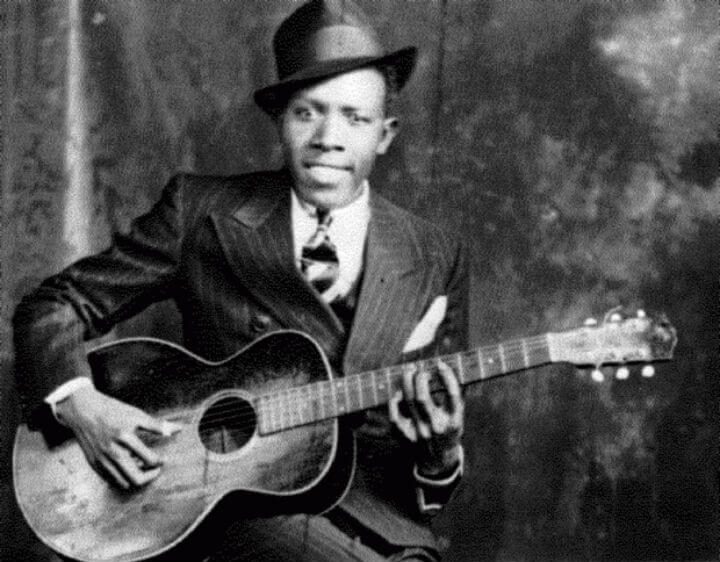fell down on my knees.
Asked the lord above “Have mercy now save poor Bob if you please”.
Well you don’t have to head down to the crossroad, or sell your soul to the devil for a part of blues (and rock & roll) history just gotta click on the site Moments In Time and prepare to hand over about $6,000,000.
As they are claiming to be selling Robert Johnson’s Gibson L1 guitar, as seen in the 1937 studio portrait of Johnson (pic) one of only two known pics of Johnson known to exist. Used for the front cover of “The Complete Recordings” CD which every blues fan should have.
Variously described by them as “The Holy Grail” and “The greatest musical artefact of the 20th century” it certainly would be if authentic and thus the record breaking asking price, the current record at auction for a guitar associated with one artist being the $959,500 Guitar Center coughed up for Eric Clapton’s “Blackie” strat, though Hendrix’s Woodstock Strat cost one owner $1.3m and an autographed Strat raised £2.8m for charity.
Plenty of evidence is offered to the L1’s authenticity but most of it just based on photos, you have to wonder what the ownership line of the instrument is, if real it would even make me go against my usual aversion to acoustics, though don’t know if I could meet the asking price.
Why “The Holy Grail”, well many see Robert Johnson as the starting point and is the influence of many guitarists & musicians from to Elmore James to Jack White, through Eric Clapton The Rolling Stones, Jimmy Page, Bob Dylan, JJ Cale, many have covered Johnson tracks.
After all who hasn’t heard “Sweet Home Chicago”, “Love In Vain” or “Cross Road Blues” and if not why not ?
Added to this the rumours of of his life and lifestyle, selling his soul to the devil down at the crossroads, the stories about how he died – at age of 27 in 1938 – reputedly poisoned by a lover’s jealous husband, went a way to create a great image of the mythical bluesman.
And so the delta bluesman, born in Mississippi in 1911, who only recorded 29 songs (with the addition of various alternative takes on “the Complete Recordings” discs) is regarded as “the father of rock & roll”.
That’s why this guitar could be so important…

The Gibson L1 offered for sale looks very similar to the one in the portrait however I tend to agree with comments on various sites that the one in the portrait is more worn than the one offered for sale.
My first argument is the way lacquer is applied to guitars. The wood is first sealed then a colour coat is applied and then clear top coats If you look at the portrait photo, the treble side of the upper bout shows a very dark area followed by a lighter area and finally a white area. This occurs as you wear through the clear coat then the colour coat and finally reach the wood
The explanation given for this is lighting. My second point is that some of the brightness could be from lighting however the light is coming from the wrong direction. Look at the shadows on his fingers. The guitar is pointing away from the light source therefore unlikely to reflect the light back to the camera. I would need to examine the negative of the portrait and the guitar too, as there could be damage on the negative The arguments given by the sales people, is insufficient to convince me.
I have been a Luthier for 30 years and have researched and worked with historical instruments in England and Europe. For $6 million I would want a lot more proof than being offered.
I would be interested in other professional opinions.
J.D.
I know what you mean, to expect people to believe it’s the real deal you’d think they’d come up with better evidence than comparing it to an album cover.
Some mention of the ownership would be handy for a start.